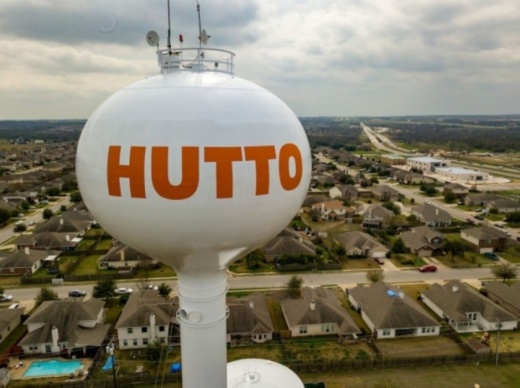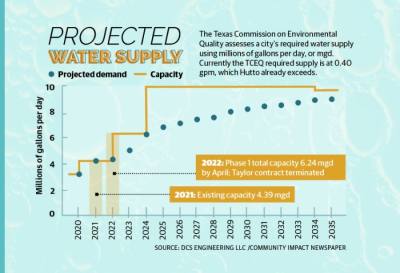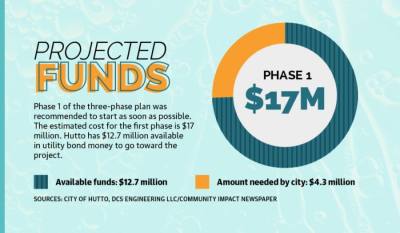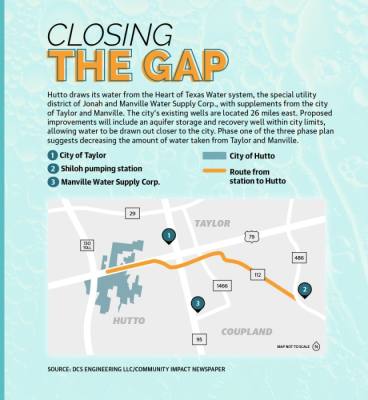Following City Council’s March 4 approval of plans for Phase 1 of a three-phase project, water supply improvements are on the horizon for Hutto, designed to utilize the city’s current system and make it less reliant on water supplements from outside sources.
“To be able to supply [future residents] with water, we’re going to need more water than we currently have,” Hutmacher said. “What this does, on a longer term basis, determines where we’re going to get that water from and how much it’s going to cost us to be able to produce it.”
Where’s the water
Overall, Hutto draws its water from four sources: Hutto’s Heart of Texas water system, the special service district of Jonah, Manville Water Supply Corp. along with additional supplements from Manville and the city of Taylor, Hutmacher said.
Hutto bought its current system, located at the Shiloh pumping station, from the Heart of Texas Water Suppliers in 2017 for $59 million.
City Council Member Peter Gordon said residents living north of Limmer Loop receive their water from Jonah. Residents living in between Limmer Loop and Carl Stern Drive receive their water from Hutto’s water system. Residents living south of Carl Stern Drive receive their water from Manville. Residents who receive their water from Hutto’s system get supplements from Manville and the city of Taylor.
Hutto’s contracts with Taylor and Manville are both take or pay contracts, meaning a base rate is guaranteed to the seller no matter how much water is taken. Hutto entered into its 40-year contract with Taylor in 2002. The city pays Taylor $4.30 per 1,000 gallons with a minimum of 175,000 gallons per day and a monthly base rate of $5,607, Hutto Public Information Officer Stacy Schmitt said. The 15-year Manville contract was signed in 2019 for a cost of $3.50 per 1,000 gallons with a minimum of 200,000 gallons a day. If Hutto goes over 600,000 gallons a day, the city owes Manville an additional 20% of the rate, Schmitt said.
During the winter storm in mid-February when Taylor and Manville could no longer supply the city with water supplements, Hutto was left with its three wells, Gordon said. Then the pumps for two of the wells became not operational, leaving only one pump operational for the entire city, resulting in lower water pressure.
City employees worked 24/7 to keep the system running and were able to get one of the pumps back online within a couple of days, Gordon said.
“If somebody else owned the system, maybe they would have just given up,” he said.
After seeing the persistence of Hutto city employees to keep the system up as long as they could, Gordon said it speaks to Hutto’s ability to control its destiny with its own system.
Reevaluating the system
After being contracted to evaluate Hutto’s current system, DCS Engineering LLC presented its recommendations to the City Council on Feb. 10 for improvements that would address the city’s short-, middle- and long-term water needs.
The first of the three-phase plan consists of creating three new wells to draw from the Simsboro Aquifer, maximizing Hutto’s existing water source, according to city documents. An aquifer storage and recovery well will be created to store excess water during times of low demand to be used in the summertime when demand peaks.
The city’s existing wells are 26 miles to the east of the Shiloh pumping station, located near the Williamson County and Lee County lines. Because the aquifer storage and recovery well will be within the city limits, the water from Shiloh can be stored and drawn out closer to Hutto, Gordon said.
Phase one also includes reducing the amount of water taken from Taylor and Manville to the minimum volumes per their contracts. This would save Hutto $160,000 per year, according to DCS Engineering.
The recommendation for phase one suggests eventually discontinuing the Taylor and Manville water supply contracts, which would save the city $700,000 a year.
Taylor’s contract is set to expire in 2042 and Manville’s expiration is in 2034, Schmitt said.
Paying for the project
Overall, phase one is expected to cost around $17 million. Hutto currently has $12.7 million available in utility bond money that could be used for the project. In 2017, Hutto issued over $80 million in certificates of obligation—bonds that do not require voter approval and allow local governments to fund public works projects, Schmitt said. This funding allowed the city to purchase the current water system and fund other utility and tax-supported projects.
While the plans for the project were approved in the March 4 meeting, Council Member Tanner Rose said the team working on the project will have to come back and present the costs for council to approve.
With around $4.3 million still needed to pay for the estimated cost of phase one, the city will have to figure out where to get the funds. Council Member Dan Thornton said he is not in favor of increasing rates for residents and does not want to consider it as an option.
The base water rate for Hutto residents is $7.82 for 0-5,000 gallons of water. By comparison, the base water rate in Pflugerville is $3.80 for 0-3,000 gallons of water. Round Rock’s base rate is $2.56 per 1,000 gallons for 0-15,000 gallons.
When Ida and James Weaver moved to Hutto six years ago, they noticed that their water bill rates were higher than when they had lived in cities such as Dallas and Houston.
“It shocked us the first time we got our first water bill,” Ida Weaver said. “It goes up all the time.”
One month the Weavers bill ran over $200. Ida Weaver said it was during a time when she was gardening and using more water than usual.
Reducing the volume of water received from the Taylor and Manville contracts would save the city a little bit of money that could be used for the project, Thornton said. Water impact fees for new developments also help contribute to the funds.
With each home in a new development, there is a set impact fee for the water supply and wastewater system. Hutto had some of the lowest water impact fees in the area for a long time, Thornton said. After adjusting the fees in February, new developments will contribute more to make up for what the city is increasing in the infrastructure, he said.
Phase one, expected to be completed in September 2022 will not have to be paid all at once. Some project items, such as a rate study, will have to be paid in the near future, while others are paid as they are built.
Moving forward
Over the last two years, Gordon said he has heard arguments for and against Hutto’s purchase of the Heart of Texas system. Having DCS Engineering assess it allowed for an outside perspective to give impartial improvement recommendations to match the city’s population growth.
“What I heard them say was, ‘It would be a mistake to sell off this system; it would be better to invest in it,’” he said.
When Rose initially heard the presentation, he said he thought the project was too good to be true but was pleasantly surprised, and is excited to have a roadmap of growth and expenses moving forward.
The City Council is currently waiting for a rate study to be presented to assess if current water rates are too high or low. Once the study is presented, Rose said he is hopeful that Hutto residents will receive some relief in their billing.








